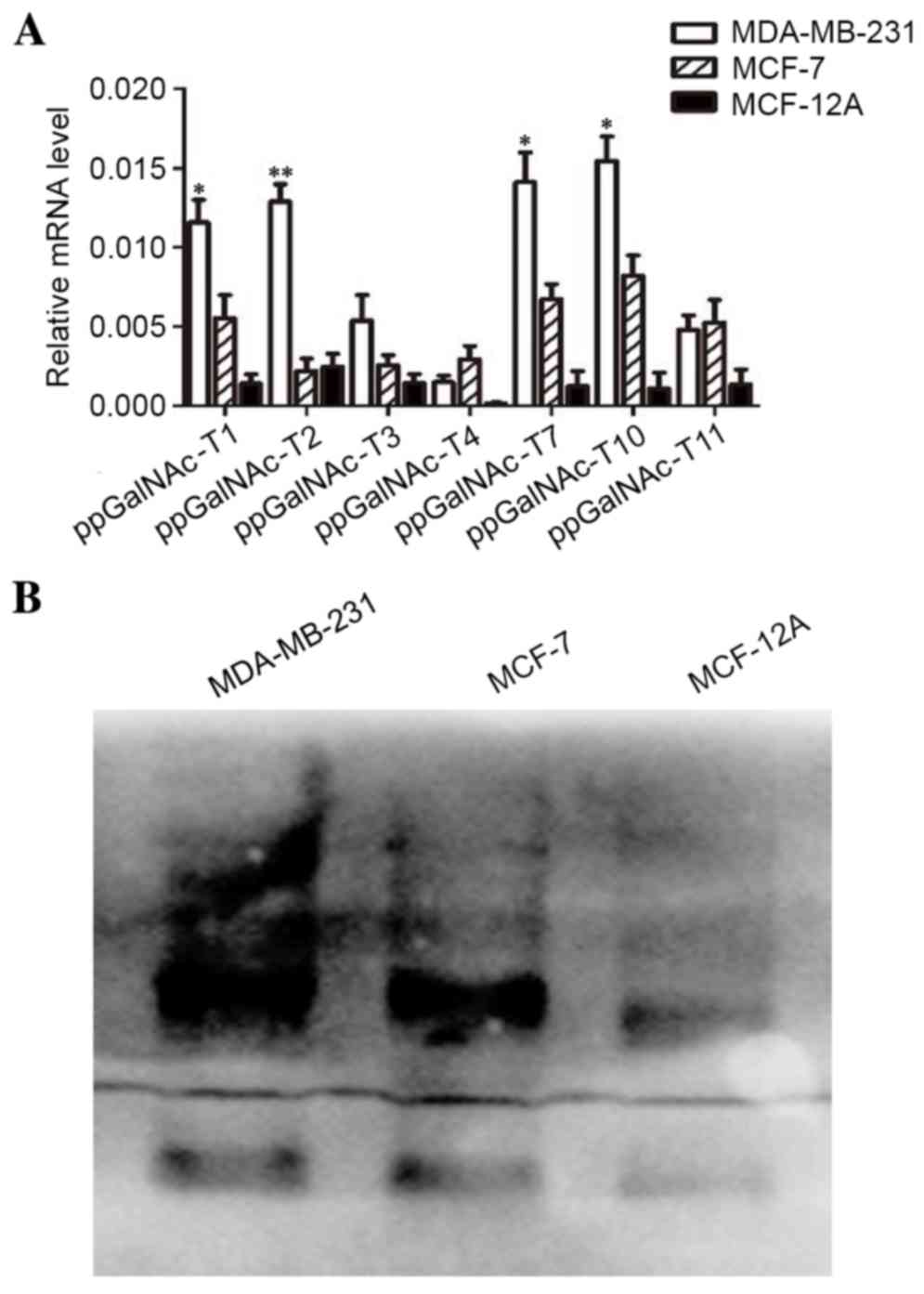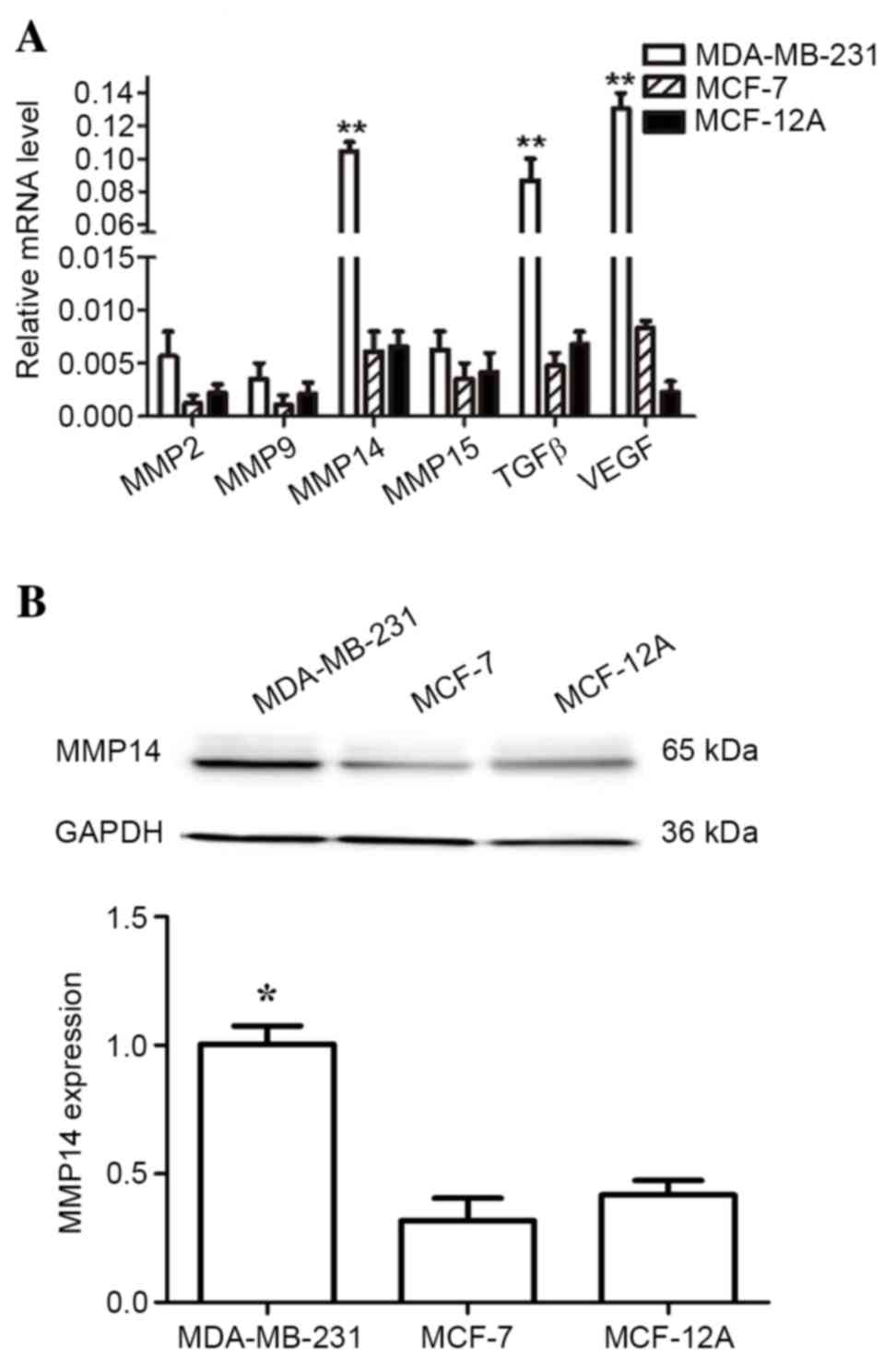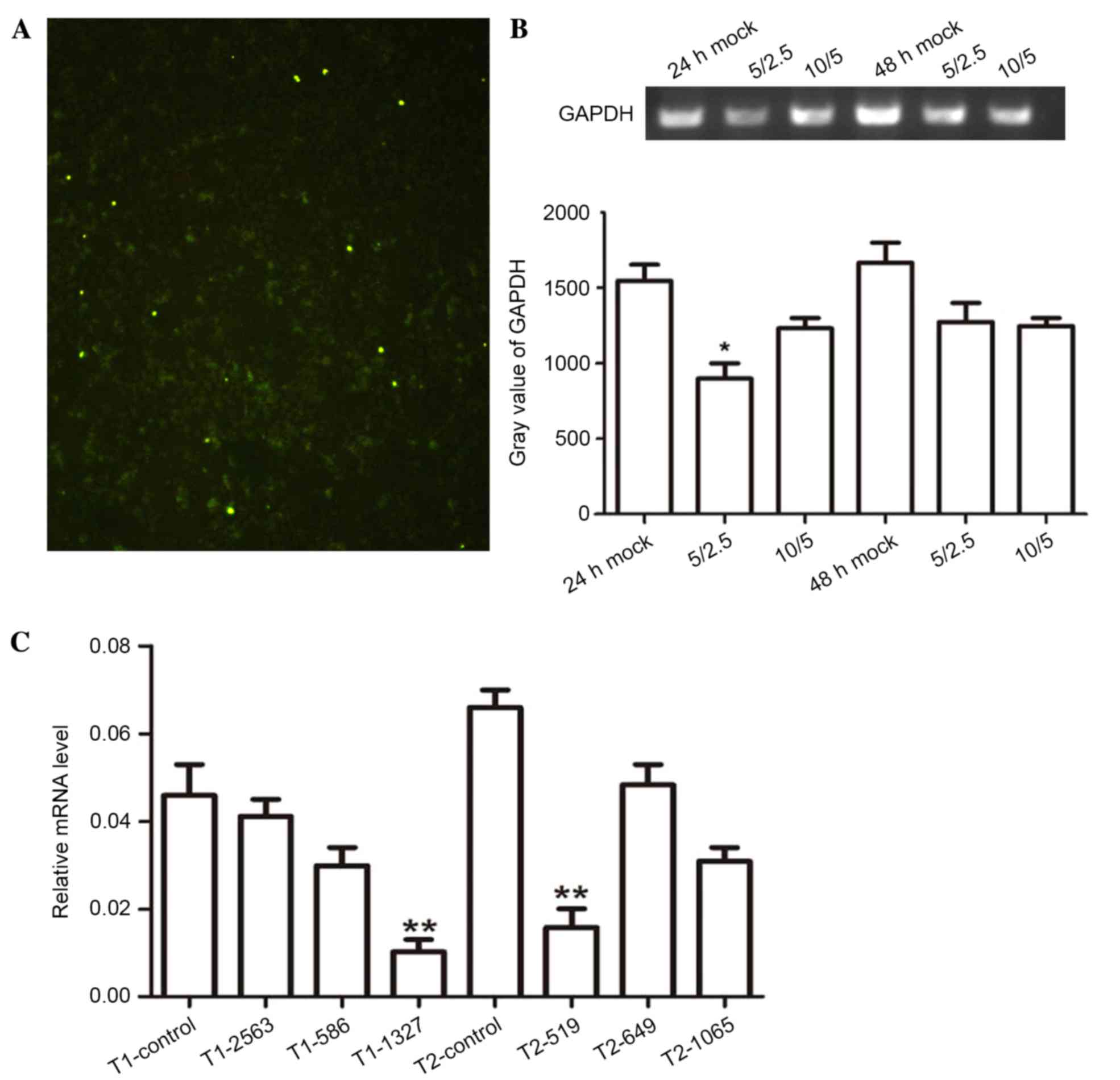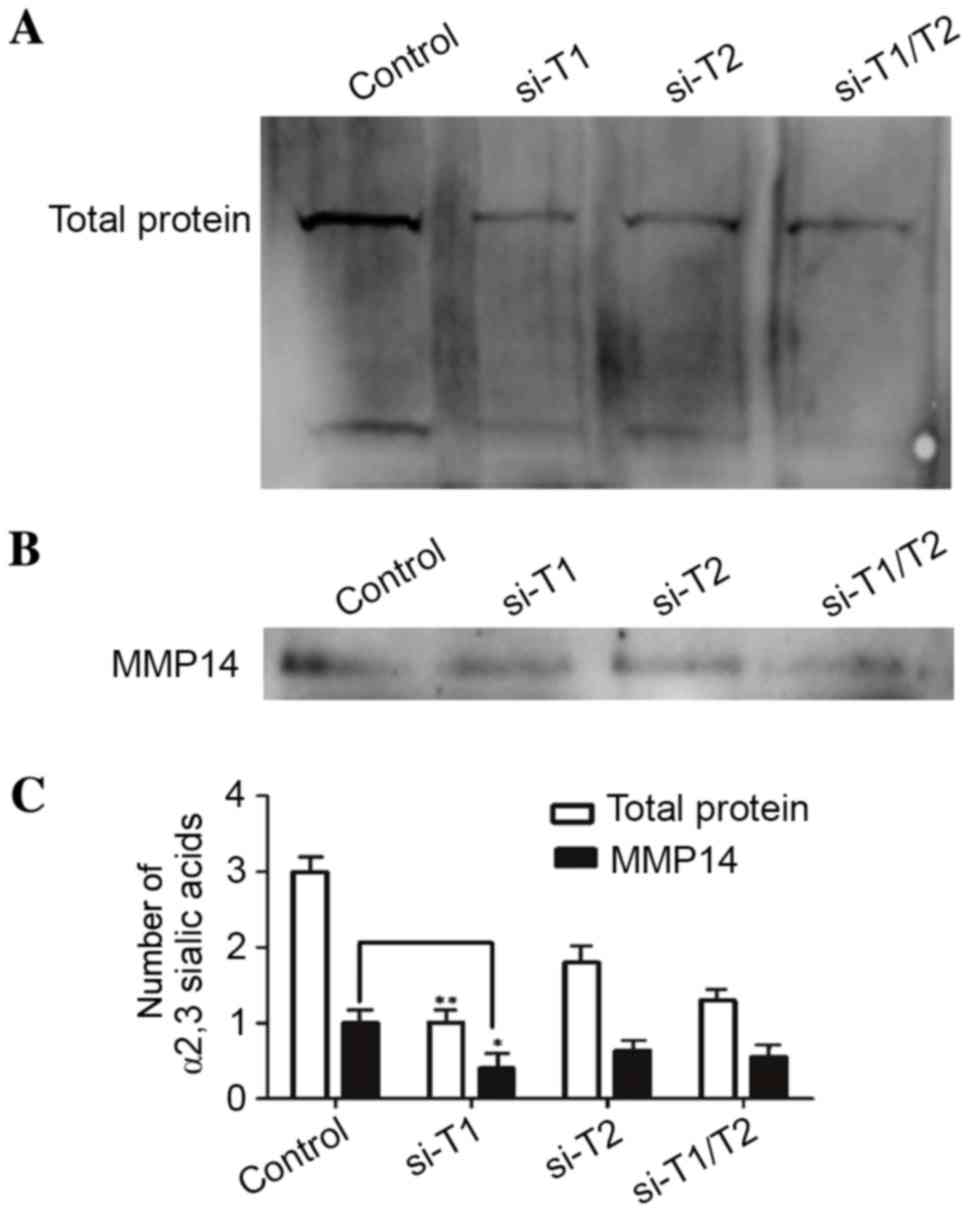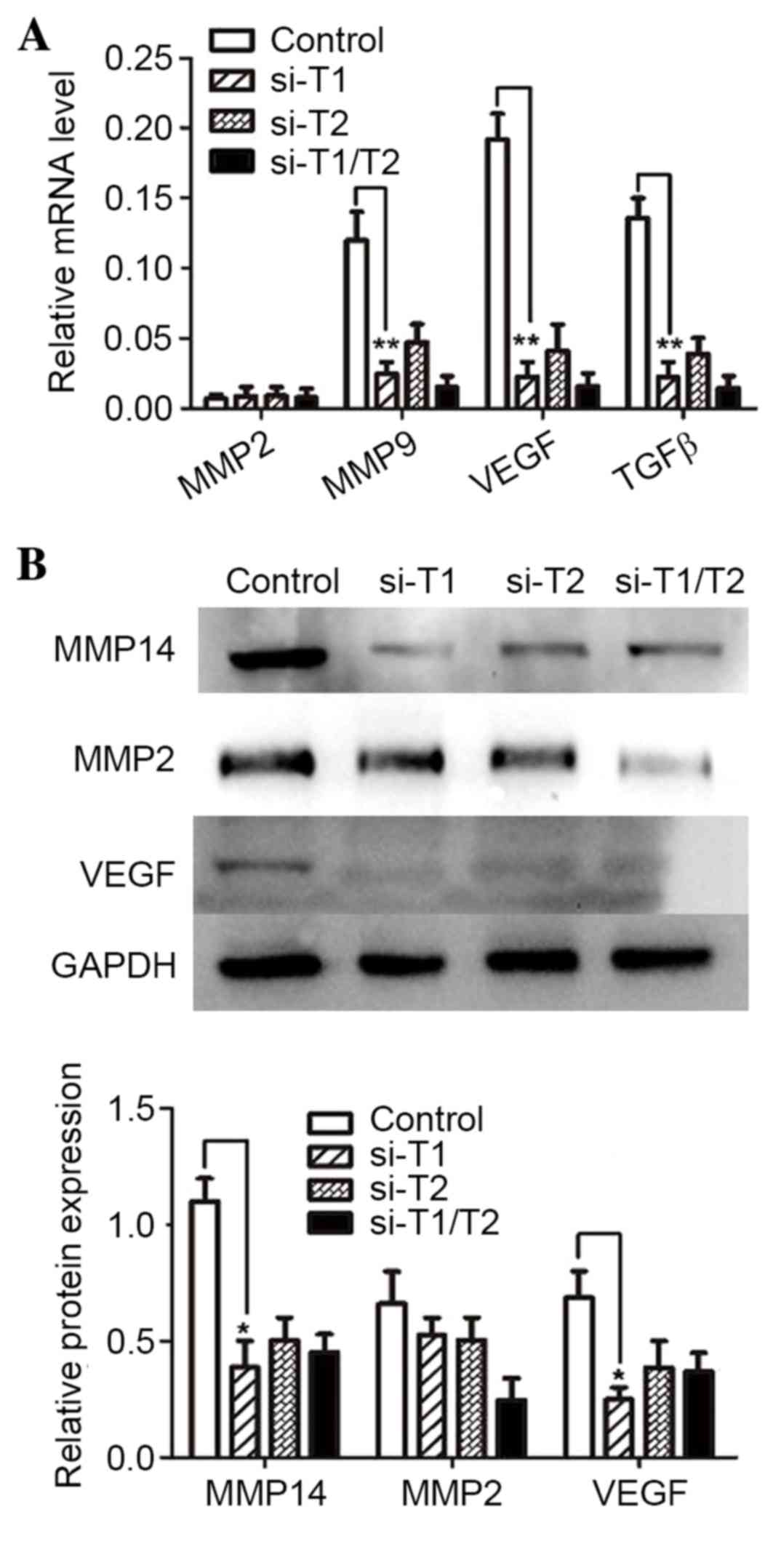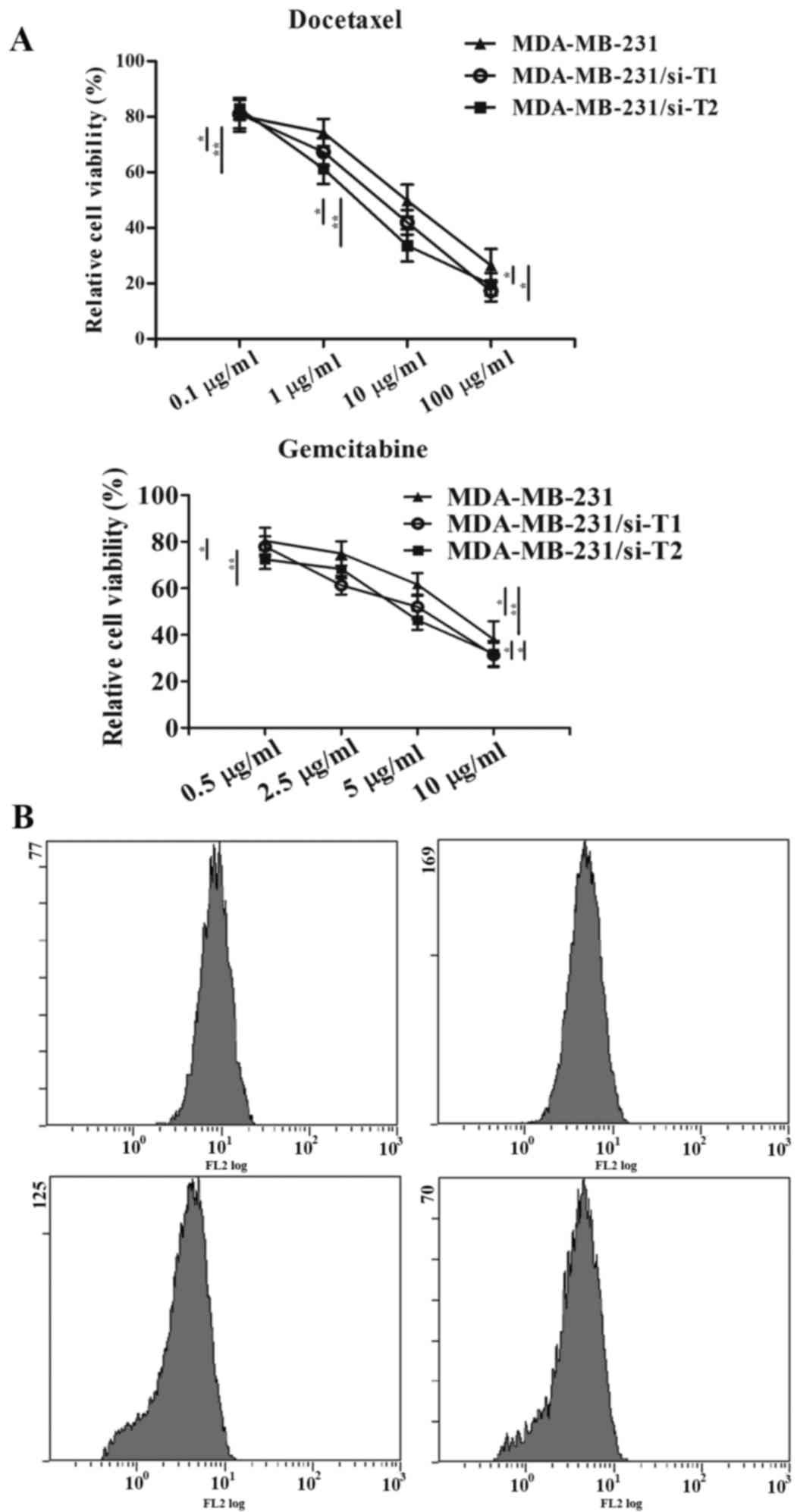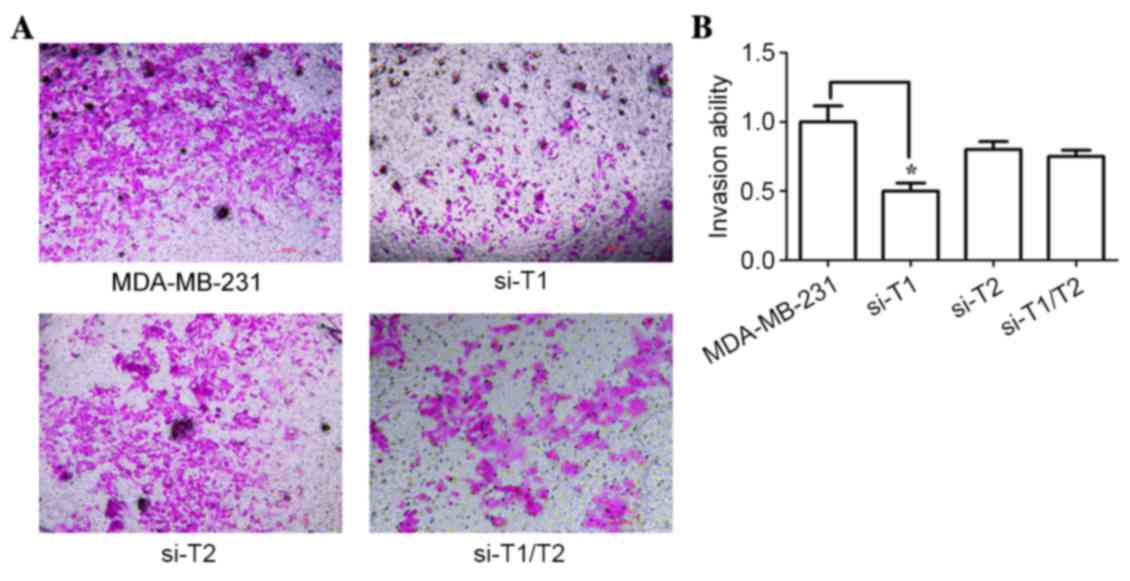RNA interference-mediated silencing of ppGalNAc-T1 and ppGalNAc-T2 inhibits invasion and increases chemosensitivity potentially by reducing terminal α2,3 sialylation and MMP14 expression in triple‑negative breast cancer cells
- Authors:
- Published online on: April 7, 2017 https://doi.org/10.3892/mmr.2017.6449
- Pages: 3724-3734
Abstract
Introduction
Breast cancer is the most common cancer diagnosed in women (1). Previous studies involving gene expression profiling and molecular pathological analyses have demonstrated that approximately 10–12% of breast cancer patients are diagnosed with triple-negative breast cancer (TNBC), and 80% of TNBCs demonstrate the basal-like gene expression pattern (2). TNBCs are characterized by the absence of estrogen and progesterone receptors, as well as human epidermal growth factor receptor-2. Therefore, endocrine therapy is not recommended as a treatment option for patients with TNBC, and conventional chemotherapy is currently the only treatment option. In the clinic, poor prognosis, high recurrence rates, and drug resistance in patients with TNBC are considered to be the negative outcomes of conventional chemotherapy. Therefore, current studies have focused on identifying novel targets that may be applied for the prediction and treatment of breast cancer. For instance, luminal-like breast cancers that present with upregulation of the glucosaminyl (N-acetyl) transferase-1 gene are more aggressive than basal-like breast cancers (3). In addition, O-glycosylated mucin 1 has been used as a biomarker for breast cancer (4).
Over 50% of all secreted and cellular proteins undergo glycosylation as a post-translational modification. Glycans, located on glycoproteins, participate in a number of biological processes, including immune responses, signal transduction pathways, invasion, metastasis and drug tolerance (5,6). Glycan overexpression generally results in the generation of a dense glycosylation network, which covers the cell surface and protects the tumor from detection and drug exposure (7). O- and N-glycosylation are the two main types of glycosylation in cells (8). O-glycosylation on the surface of epithelial cells in various organs, including the colon, breast and stomach, has a higher molecular weight than N-glycosylation (9). O-glycosylation is a complex process that involves several glycosyltransferase enzymes. Cancer-associated O-glycans have been attributed, at least in part, to alterations in the expression of key glycosyltransferases (10). O-glycans begin with a Tn antigen, which is catalyzed by the polypeptide N-acetylgalactosaminyltransferases (ppGalNAc-Ts), and end with sialic acids, fucose and sulfate (11). Cancer-associated O-glycans may be highly sialylated and less sulfated. Sialylation enzymes are further classified into four families based on their substrates and tissue distribution specificities, including sialyltransferase (ST)-3 Gal (α2,3-ST), ST6Gal (α2,6-ST), ST6GalNAc and ST8Sia (α2,8-ST) (12,13). In breast cancer, α2,6 sialylation contributes to cell-to-cell adhesion of MDA-MB-435 cells (14). In addition, overexpression of α2,3-ST results in the production of core 1-based sialylated glycans in MDA-MB-231 and T47D cells (15). Furthermore, ST3Gal I may be a tumor promoter in breast cancer, as indicated by mammary tumor development in ST3Gal I/PyMT mice (16).
Cell type-specific glycosylation maintains and stabilizes the conformation of peptides and proteins, and affects their physical and chemical properties. Matrix metalloproteinase-14 (MMP14) is a collagenolytic enzyme that is involved in various pathological processes, such as cancer invasion and metastasis (17). MMP14 is located on the cell surface and consists of a short transmembrane domain, a cytoplasmic tail, and four potential O-glycosylation sites at its hinge region. Previous studies have identified four potential target sites on MMP14 (Thr291, Thr299, Thr300, and Ser301) (18). MMP14 is regulated at the transcriptional and post-transcriptional levels by multiple coordinated mechanisms. Incomplete glycosylation stimulates extensive autocatalytic degradation and self-inactivation of MMP14. In addition, terminal sialylation is an important functional moiety of the glycoprotein region of MMP14 (19).
Taking into account the results of previous studies, the present study investigated the role of ppGalNAc-T1 and ppGalNAc-T2 in the initiation of O-linked glycosylation, and explored their effects on the terminal α2,3-sialylation of MMP14. The results of the present study indicated that ppGalNAc-T1 serves a more important role than ppGalNAc-T2 in mediating the initiation of GalNAc-O-Ser/Thr (Tn antigen). In addition, abnormal O-linked glycosylation initiation caused by the inhibition of glycosyltransferase via RNA interference (RNAi), led to a decrease in α2,3 terminal sialylation, which was correlated to the self-proteolysis of MMP14. Furthermore, a low density of cell surface α2,3-sialic acid contributed to an increase in intracellular drug uptake, as well as antineoplastic and antitumor drug effects. These effects resulted in decreased invasion and metastatic capabilities of MDA-MB-231 cells.
Materials and methods
Cell line
The highly invasive MDA-MB-231 cell line, the poorly invasive luminal A MCF-7 cell line and the normal-like MCF-12A cell line, were purchased from the American Type Culture Collection (Manassas, VA, USA) and were used for the purposes of the present study. All breast tumor cells were maintained at 80% confluence in Dulbecco's Modified Eagle's medium (DMEM, Gibco; Thermo Fisher Scientific, Inc., Waltham, MA, USA) supplemented with 10% fetal bovine serum (FBS, Gibco; Thermo Fisher Scientific, Inc.), 2 mM glutamine (Sigma-Aldrich; Merck-Millipore, Darmstadt, Germany), 10 mM HEPES buffer (Sigma-Aldrich; Merck-Millipore), and penicillin (100 IU/ml)-streptomycin (100 g/ml) (Beyotime Institute of Biotechnology, Haimen, China) at 37°C in a humidified atmosphere (5% CO2).
RNAi assay
siRNA-ppGalNAc-T1 and siRNA-ppGalNAc-T2 were purchased from Shanghai GenePharma Co., Ltd. (Shanghai, China) and were generated by subcloning multiple ppGalNAc-T1 and ppGalNAc-T2 cDNAs, respectively (Table I). MDA-MB-231 breast tumor cells were seeded onto a 6-well plate at a density of 2×105 cells and cultured until they reached 80% confluence for transfection. Cells were transfected with 5 ml siRNA-ppGalNAc-T1 and/or siRNA-ppGalNAc-T2 vectors, using Lipofectamine™ 2000 (Invitrogen; Thermo Fisher Scientific, Inc.) according to the manufacturer's protocol. The 5 µl empty vector, pEGFP-C1 (GenePharma Co., Ltd. Shanghai, China), was transfected into the MDA-MB-231 cells and used as a control. Transfection efficiency was determined by fluorescence microscopy (Zeiss GmbH, Jena, Germany) according to the fluorescence intensity of the control group. The optimal transfection system volume was determined using the GAPDH interference effect with different times and ratios.
Gene expression analysis by reverse transcription-quantitative polymerase chain reaction (RT-qPCR)
Total RNA was extracted from 1.5×106 MDA-MB-231 cells and 1.5×106 MDA-MB-231 cells that transfected with siRNA using TRIzol reagent (Invitrogen; Thermo Fisher Scientific, Inc.) and treated with DNase I (Ambion; Thermo Fisher Scientific, Inc.) according to the manufacturer's protocol. RNA concentration and quality was measured using an ultraviolet spectrometer at a wavelength ratio of 260/280 nm. cDNA was synthesized from 1 µg total RNA using an RNA reverse transcription diagnostic kit (Takara Bio, Inc., Otsu, Japan). PCR reaction mixtures (30 µl) were amplified with 40 cycles of denaturation at 95°C for 60 sec, annealing at 56°C for 60 sec and extension at 72°C for 120 sec. In addition, RT-qPCR reaction mixtures (25 µl) were amplified using 40 cycles of denaturation at 95°C for 60 sec, annealing at 95°C for 15 sec and extension at 60°C for 60 sec. RT-qPCR was performed using an ABI PRISM 7500 Sequence Detection system (Applied Biosystems; Thermo Fisher Scientific, Inc.) using SYBR Green Realtime PCR Master Mix (Toyobo Co., Ltd., Osaka, Japan). Gene expression was quantified using the 2−∆ΔCq method (20) following normalization to the expression of GAPDH. The primer sequences used for RT-qPCR analysis are presented in Table II.
Table II.Sequences of primers used for reverse transcription-quantitative polymerase chain reaction analysis. |
Western blot analysis
MDA-MB-231 cells (1.5×106) and MDA-MB-231 cells (1.5×106) that transfected with siRNA were harvested and homogenized with lysis buffer, consisting of 50 mM Tris-HCl (pH 7.3), 150 mM NaCl, 1 mM EDTA, 1% Triton X-100 and 1% protease inhibitor cocktail (Beyotime Institute of Biotechnology). Total protein (15 µg) from each well was boiled for 10 min in 17% Laemmli buffer (Beyotime Institute of Biotechnology) and separated via 10% SDS-PAGE, before samples were transferred to a polyvinylidene difluoride (PVDF) membrane using a semi-dry technique. The membranes were blocked for ~1.5 h with 5% skim milk in Tris-buffered saline (TBS), containing 10 mM Tris, 150 mM NaCl (pH 7.9) and 0.05% Tween-20 (Beyotime Institute of Biotechnology). The membranes were then incubated with the appropriate primary antibodies [Anti-MMP14 antibody (cat. no. ab51074) was purchased from Abcam Co., Ltd., Cambridge, UK. GAPDH antibody (cat. no. AF0006) was purchased from Beyotime Institute of Biotechnology. Dilution, 1:1,000] at 4°C overnight. Following washing with TBS Tween-20 buffer, the cells were incubated with the appropriate horseradish peroxidase (HRP)-conjugated IgG-AP secondary antibody (Beyotime Institute of Biotechnology. Dilution, 1:1,000) at room temperature for 90 min. After washing in TBS Tween-20 buffer, detection and autoradiography were performed using a Chemiluminescence Western Blotting kit (Roche Diagnostics GmbH, Mannheim, Germany), according to the manufacturer's instructions. Blots were quantified using Quantity One software version 4.62 (Bio-Rad Laboratories, Inc., Hercules, CA, USA).
Lectin blot analysis
Whole-cell extracts were harvested and homogenized as aforementioned. Total protein (15 µg) from each well was boiled for 10 min in Laemmli buffer, separated via 10% SDS-PAGE, and then transferred onto a PVDF membrane using a semi-dry technique. The membranes were blocked for ~1.5 h with 3% bovine serum albumin (BSA) in phosphate-buffered saline (PBS) at room temperature, before they were incubated with biotinylated Maackia Amurensis Lectin II (MALII; dilution, 1:500) in PBS with Tween-20 buffer (PBST) for 1 h at room temperature. After washing in PBST buffer, the membranes were incubated with HRP-streptavidin (dilution, 1:1,000; Beyotime Institute of Biotechnology) for 1 h at room temperature and then washed with PBST buffer. Detection and autoradiography were performed using a Chemiluminescence Western Blotting kit (Roche Diagnostics GmbH), according to the manufacturer's protocol.
Analysis of lectin labeling by flow cytometry
Cells were digested with 0.25% trypsin (Gibco; Thermo Fisher Scientific, Inc.) and harvested in 1.5 ml Eppendorf tubes. Cell density was adjusted to 2×106/ml with lectin buffer (10 mM Hepes, 0.15 M NaCl, 0.08% sodium azide, 0.1 mM Ca2+ and 0.01 mM Mn2+, pH 7.5), before they were stained with 10 µg/ml MALII (Sigma-Aldrich; Merck-Millipore) in PBS (containing 0.5% BSA and 0.05% sodium azide) at 37°C for 120 min. The cells were then washed three times with PBS and incubated with phycoerythrin-avidin (Sigma-Aldrich; Merck-Millipore) at 37°C for 60 min. Following incubation, the cells were collected and fluorescence intensity was measured using a FACScan flow cytometer (BD Biosciences, Franklin Lakes, NJ, USA) and analyzed with BD CellQuest software version 7.5.3 (BD Biosciences).
Immunoprecipitation
1.5×106 MDA-MB-231 cells and 1.5×106 MDA-MB-231 cells that transfected with siRNA Cells were harvested and homogenized with lysis buffer as described in Western blot analysis. The primary rabbit monoclonal antibody against MMP14 (cat. no. ab51074, Abcam, Cambridge, UK) was added to the cell lysate and incubated at 4°C overnight. A total of 30 ml protein A agarose beads (Beyotime Institute of Biotechnology) was incubated with the antigen-antibody complex at 4°C for 2–4 h. The immunoprecipitation products were washed five times with cold PBS. Finally, the beads were washed with 5 µl PBS, boiled, and gently centrifuged at 2,000 × g for 2 min at room temperature, and the recovered samples were run on an 8% SDS-PAGE for lectin blotting using the aforementioned methods.
In vitro cytotoxicity assay
Drug resistance was measured by using the Cell Counting Kit-8 (CCK-8; C0038, Beyotime Institute of Biotechnology) assay. MDA-MB-231 cells and 1.5×106 MDA-MB-231 cells that transfected siRNA-ppGalNAc-T1 and siRNA-ppGalNAc-T2, were plated onto 96-well plates (Corning Life Sciences, Tewksbury, MA, USA) at a density of 2×105 and incubated with 0.1, 1, 10 and 100 ng/µl docetaxel (DOC; Jiangsu Aosaikang Pharmaceutical Co., Ltd., Nanjing, China) and 0.5, 2.5, 5 and 10 ng/µl gemcitabine hydrochloride (GEM; Qilu Pharmaceutical Co., Ltd., Jinan, China) anticancer drugs for 48 h. Cells were then treated with 100 ml CCK-8 (Beyotime Institute of Biotechnology) and incubated at 37°C and 5% CO2 for 4 h. The absorbance value, at a wavelength of 450 nm, was measured using a microplate reader (Thermo Fisher Scientific, Inc.,). Each group contained three wells and was prepared in triplicate. The drug concentrations that resulted in 50% growth inhibition (the half maximal inhibitory concentration, IC50 value) were determined.
Transwell invasion assays
In order to evaluate the invasion ability of the cells transfected with siRNA-ppGalNAc-T1 and siRNA-ppGalNAc-T2, Transwell plates (Corning Life Sciences) with a filter diameter of 6.5 mm and a pore size of 8.0 µm were employed. According to the manufacturer's instructions, cells (density, 1×105) were plated into the upper chambers of 8-µm Transwells in serum-free medium, and incubated for 24 h to generate serum-starved cells. Following serum starvation, the culture medium was decanted and 500 µl DMEM was added to the upper chamber, while 500 µl DMEM plus 10% FBS was introduced to the lower compartment. The cells and Matrigel (included in the Transwell plates) were incubated at 37°C for 24 h, before washing twice with pre-heated PBS. The filters were subsequently fixed with 1 ml 1% paraformaldehyde for 15 min at room temperature. Following removal of the paraformaldehyde solution with PBS, the cells and Matrigel were stained with 500 µl eosin staining solution (Beyotime Institute of Biotechnology) for 20 min at room temperature, and then rinsed twice with distilled water. Cell penetration through the membrane was quantified by counting the number of cells that had diffused through the membrane in 10 fields of view (magnification, ×200) using a light microscope. Experiments were performed in triplicate.
Statistical analysis
Results are expressed as the mean ± standard deviation of triplicate experiments. Statistically significant differences were determined using SPSS version 16.0 software (IBM SPSS, Armonk, NY, USA). The independent samples t-test was performed to compare the data collected from independent samples. P<0.05 was considered to indicate a statistically significant difference.
Results
Differential expression of glycosyltransferases and α2,3-sialic acid in highly and poorly invasive breast cancer cells
In order to determine the expression level of glycosyltransferase enzymes in breast cancer cells, the expression levels of ppGalNAc-T1, T2, T3, T4, T7, T10 and T11 in highly invasive [estrogen receptor (ER)-negative] MDA-MB-231 cells and poorly invasive (ER-positive) MCF-7 cells, as well as in normal-like MCF-12A mammary cells. The mRNA expression level of these genes was detected by RT-qPCR analysis. As shown in Fig. 1A, the expression of ppGalNAc-T1, T2, T7 and T10 in MDA-MB-231 cells was significantly higher when compared with MCF-7 and MCF-12A cells (T1: P-value, MDA-MB-231 vs. MCF-7=0.035, MDA-MB-231 vs. MCF-12A=0.0096; T2: MDA-MB-231 vs. MCF-7=0.022, MDA-MB-231 vs. MCF-12A=0.0082; T7: MDA-MB-231 vs. MCF-7=0.028, MDA-MB-231 vs. MCF-12A=0.0075; T10: MDA-MB-231 vs. MCF-7=0.031, MDA-MB-231 vs. MCF-12A=0.0062). In addition, the expression of α2,3 sialic acid was detected by lectin blot analysis. As shown in Fig. 1B, α2,3-sialic acid was expressed in breast cancer cells and its expression in MDA-MB-231 cells was markedly higher when compared with MCF-7 and MCF-12A cells. Upregulation of glycosyltransferase enzymes promotes O-glycosylation, which may, in turn, lead to the increased production of terminal α2,3-sialic acids in highly invasive breast cancer cells (21). Considering the strong catalytic activity of glycosyltranferase enzymes on peptide substrates of ppGalNAc-T1 and -T2, the present study assessed the importance of ppGalNAc-T1 and -T2 in O-linked glycosylation initiation. In addition, the inhibitory effects of downstream sugar chain extension on tumor invasion and the metastatic potential of breast cancer cells was examined.
Differential expression of MMPs, vascular endothelial growth factor (VEGF) and transforming growth factor β (TGFβ) in breast cancer cells at various degrees of malignancy
Of the identified members of the MMP family, MMP2 is an enzyme that has been reported to directly participate in the degradation of the extracellular matrix (ECM). By contrast, MMP14 is involved in tumor invasion and metastasis through activation of pro-MMP2 (22). In order to investigate the expression of metastasis-associated genes in breast cancer cells, the present study measured the expression of the MMP2, MMP9, MMP14, MMP15, TGFβ and VEGF genes in MDA-MB-231, MCF-7, and MCF-12A cell lines by RT-qPCR analysis. Fig. 2A shows that MMP14, TGFβ, and VEGF expression levels were significantly increased in highly invasive MDA-MB-231 cells, when compared with MCF-7 and MCF-12A cells. Upregulation of MMP14, TGFβ, and VEGF is associated with tumor invasion, metastasis and angiogenesis (23). No alterations in the expression levels of MMP2 among these cell lines were observed. Out of all MMP proteins examined, only MMP14 was significantly upregulated in MDA-MB-231 breast cancer cells at the mRNA and protein levels (Fig. 2A and B). These results suggest that MMP14 may serve an important role in the invasion and metastasis of breast cancer cells.
Silencing of ppGalNAc-T1 and ppGalNAc-T2 in MDA-MB-231 cells by RNAi
To further explore the role of ppGalNAc-T1 and ppGalNAc-T2 in breast tumors, highly invasive MDA-MB-231 cells were transiently transfected with siRNA-ppGalNAc-T1 and for siRNA-ppGalNAc-T2. The transfection efficiency was 72% and was determined by fluorescence microscopy (Fig. 3A). The optimal transfection system volume was determined using the GAPDH interference effect (Fig. 3B). ppGalNAc-T1 and ppGalNAc-T2 mRNA levels in MDA-MB-231 cells were then measured using RT-qPCR analysis. The expression levels of ppGalNAc-T1 and ppGalNAc-T2 were significantly downregulated following transfection with siRNA-ppGalNAc-T1-1327 and siRNA-ppGalNAc-T2-519 vectors, respectively, when compared with control vectors (Fig. 3C, P=0.0071, P=0.0093). These results demonstrated the optimal concentration and interference fragments required to silence the expression of ppGalNAc-T1 and ppGalNAc-T2 in MDA-MB-231 cells. The results presented were used to further examine the role of ppGalNAc-T1 and ppGalNAc-T2 in breast cancer cells.
Effect of silencing ppGalNAc-T1 and ppGalNAc-T2 on the expression of α2,3-sialic acid in MDA-MB-231 cells
ppGalNAc-Ts catalyze the attachment of the first GalNAc monosaccharide to the polypeptide during the initiation of O-linked glycosylation. The final step of O-linked glycosylation is terminal sialic acid acidification, and the metabolic flux through the sialic acid synthesis pathway is associated with substrate availability (11). Thus, the downregulated expression of ppGalNAc-T1 and ppGalNAc-2 by RNAi may reduce terminal sialic acidification. Fig. 4A demonstrates that the terminal sialic acid in the RNAi groups was downregulated when compared with the control group. In addition, downregulation of ppGalNAc-T1 in MDA-MB-231 cells resulted in a lower density of sialylated proteins when compared to that of the siRNA-ppGalNAc-T2 groups and the co-interference groups. The findings presented in the current study indicated that the sialic acid structure of O-glycans in glycoproteins generally decreased due to the reduction in substrate following the downregulation of ppGalNAc-T1. ppGalNAc-T1 serves an important role in O-glycosylation of MMP14 due to the presence of potential O-glycosylation sites at the hinge region of MMP14, which was demonstrated by the results of the lectin blot analysis of α2,3 sialic acids, including the 65 kDa protein of MMP14 proteins (Figs. 1B and 2B). Based on these results, the authors hypothesized that an α2,3 sialylation event had occurred at the hinge region of MMP14. Fig. 4B demonstrated the detection of α2,3 sialic acids on MMP14 using an immunoprecipitation assay, and the expression of α2,3 sialic acids in the RNAi groups was downregulated. The siRNA-ppGalNAc-T1 group exhibited a lower density of α2,3 sialic acids when compared with the siRNA-ppGalNAc-T2 and co-transfection groups. These results suggest that α2,3 sialylation occurs in the hinge region of MMP14, and terminal sialylation is regulated by the initiation of O-glycosylation.
Effect of silencing ppGalNAc-T1 and ppGalNAc-T2 on the expression of MMPs, VEGF and TGFβ
Fig. 2 demonstrated that MMP14, VEGF, and TGFβ were upregulated in MDA-MB-231 cells when compared with MCF-7 and MCF-12A cells. MMP14 is a key enzyme involved in tumor invasion and angiogenesis through activation of pro-MMP2 and regulating VEGF (24). Incomplete glycosylation of this glycoprotein stimulates extensive autocatalytic degradation and self-inactivation of MMP14 (19). Due to the decrease in terminal α2,3 sialic acids on MMP14 by transient transfection of siRNA constructs against ppGalNAc-T1 and ppGalNAc-T2, the expression of MMP14, MMP2 and VEGF were measured by RT-qPCR and western blot analyses. Fig. 5A shows that MMP9, VEGF, and TGFβ mRNA expression was downregulated. MMP14 may activate MMP2 at post-transcription level; therefore, the MMP2 mRNA expression remained unchanged. Fig. 5B shows that MMP14 protein expression was downregulated in the RNAi groups, which was consistent with the immunoprecipitation results presented in Fig. 4B. In addition, alterations in the protein expression patterns of MMP2 and VEGF were similar to that of MMP14 in all experimental groups. Thus, decreasing α2,3 sialylation by silencing ppGalNAc-T1 may lead to extensive autocatalytic degradation and self-inactivation of MMP14.
Knockdown of ppGalNAc-T1 and ppGalNAc-T2 increases chemosensitivity to DOC and GEM
Chemotherapy resistance is a major obstacle for the successful treatment of TNBC with chemotherapeutic agents. The effect of ppGalNAc-T expression on the sensitivity of TNBC cells to anticancer drugs remains elusive. In order to examine its effect in more detail in the present study, the expression of ppGalNAc-T1 and ppGalNAc-T2 was inhibited by RNAi in MDA-MB-231 cells prior to treatment with DOC (0.1–100 µg/ml) or GEM (0.5–10 µg/ml) for 48 h. As shown in Fig. 6A, downregulation of ppGalNAc-T1 or ppGalNAc-T2 resulted in a greater reduction in the proliferation of MDA-MB-231 cells treated with DOC and GEM, when compared cells treated with DOC and GEM alone (P-values, 1 µg/ml DOC, MDA-MB-231-si-T2: MDA-MB-231=0.003, MDA-MB-231-si-T1: MDA-MB-231=0.042; 10 µg/ml DOC, MDA-MB-231-si-T2: MDA-MB-231=0.0026, MDA-MB-231-si-T1: MDA-MB-231=0.038; 100 µg/ml DOC, MDA-MB-231-si-T2: MDA-MB-231=0.041, MDA-MB-231-si-T1: MDA-MB-231=0.040; P-values, 0.5 µg/ml GEM, MDA-MB-231-si-T2: MDA-MB-231=0.031; 2.5 µg/ml GEM, MDA-MB-231-si-T1: MDA-MB-231=0.002; 5 µg/ml GEM, MDA-MB-231-si-T1: MDA-MB-231=0.034, MDA-MB-231-si-T2: MDA-MB-231=0.001; 100 µg/ml GEM, MDA-MB-231-si-T2: MDA-MB-231=0.046, MDA-MB-231-si-T1: MDA-MB-231=0.044). The IC50 values of the drugs were significantly lower in the ppGalNAc-T1 siRNA (ICDOC50=7.3, P=0.0005 vs. untreated MDA-MB-231 group; ICGEM50=6.2, P=0.021 vs. untreated MDA-MB-231 group) or ppGalNAc-T2 siRNA (ICDOC50=3.8, P=0.0002 vs. untreated MDA-MB-231 group; ICGEM50=5.7, P=0.014 vs. untreated MDA-MB-231 group) group compared with those in the untreated MDA-MB-231 group (ICDOC50=19.2; ICGEM50=8.1). Therefore, downregulation of ppGalNAc-T1 or ppGalNAc-T2 in MDA-MB-231 cells resulted in increased chemosensitivity to anti-tumor drugs.
Flow cytometry assays were performed to evaluate the inhibitory effect of ppGalNAc-T1 and ppGalNAc-T2 on terminal α2,3 sialylation. Cells were treated with 10 µg/ml DOC for 48 h. Fig. 6B demonstrated a marked reduction in cell surface α2,3 sialic acids between the control group and the DOC treatment group. In addition, knockdown of ppGalNAc-T1 and ppGalNAc-T2 inhibited sialylation further following DOC treatment. These results indicate that ppGalNAc-T1 and ppGalNAc-T2 may be involved in mediating drug resistance in TNBC cells by regulating the generation of terminal α2,3 sialic acids by O-glycosylation.
Effect of silenced ppGalNAc-T1 and ppGalNAc-T2 expression on the invasion of breast cancer cells
The results presented so far, demonstrated that MMP14 expression and associated α2,3 sialylation were affected by the downregulation of ppGalNAc-T1 and ppGalNAc-T2. MMP14 is a crucial membrane enzyme that participates in tumor invasion and migration (24). Therefore, the effect of ppGalNAc-T1 and ppGalNAc-T2 expression on the capacity of breast carcinoma cells to metastasize was investigated in the present study. Transwell invasion chambers coated with Matrigel were used. Fig. 7 shows that the RNAi groups exhibited a significant reduction in invasion capabilities when compared with that of the control groups (P=0.013 <0.05). In addition, the inhibitory effect of the siRNA-ppGalNAc-T1 group was significantly higher when compared with that of the siRNA-ppGalNAc-T2 and co-interference groups (P=0.022; P=0.031). These results suggest that ppGalNAc-T1 may regulate the metastatic behavior of breast cancer cells by regulating the initiation of O-glycosylation. In addition, decreasing α2,3 sialylation through silencing of ppGalNAc-T1 may lead to extensive autocatalytic degradation and self-inactivation of MMP14. Furthermore, the glycosyltransferase ppGalNAc-T1 may serve a more important role in the glycosylation-initiation process than ppGalNAc-T2.
Discussion
Information regarding the pathogenesis of TNBC remains scarce, and requires further study. Previous clinical data has demonstrated that high histological grade, advanced disease, high recurrence rate and drug resistance influence the prognosis of TNBC patients (25–27). As there are currently no standard treatments for TNBC, researchers are conducting investigations to address this issue using a number of different methods, including the analysis of gene and receptor expression levels, immunomodulatory activities and signaling pathways (28,29). Glycomics is an emerging field of TNBC research that is currently receiving extensive attention (30).
Aberrant glycoconjugates on the cell surface are a common feature of tumor cells (31). O-linked alterations have been detected by high performance liquid chromatography and immunolocalization in various types of cancer cell lines, including MCF-7, MDA-MB-231 and T47D (15,16). O-glycan biosynthesis and its associated regulatory mechanisms are relatively complex and poorly understood.
O-linked glycosylation is initiated by ppGalNAc-T by catalyzing the addition of a single GalNAc monosaccharide to a serine or threonine residue on the polypeptide. Based on in silico analysis, a total of 24 unique human ppGalNAc-Ts genes have been identified thus far, and ppGalNAc-T isoforms display tissue-specific expression patterns in adult mammals, as well as unique spatial and temporal patterns of expression during murine development (32–34). In the present study, MDA-MB-231 cells were observed to express high levels of ppGalNAc-T1, T2, T3, T7, T10 when compared to that in MCF-7 and MCF-12A cells. ppGalNAc-T1 and ppGalNAc-T2 have been previously demonstrated to exhibit strong catalytic activity on bare peptide substrates (35). ppGalNAc-T7 (36) and ppGalNAc-T10 (37) require prior glycosylation by GalNAc for optimal activity. In addition, ppGalNAc-T1 and ppGalNAc-T2 are expressed in a wide range of normal human tissues, and at low levels in breast cancer (38). These enzymes possess housekeeping functions and are ubiquitously expressed at a low level. Silencing the expression of ppGalNAc-T1 inhibited the proliferation and tumor growth of bladder cancer (39). A previous study indicated that ppGalNAc-T2 regulates cellular metastatic behavior in gastric cancer (40). Therefore, investigation of the role of ppGalNAc-T1 and ppGalNAc-T2 on O-linked glycosylation initiation, and its inhibitory effects on downstream sugar chain extension, may facilitate an improved understanding of tumor invasion and the metastatic potential of breast cancer.
Extension and termination reactions in O-glycosylation are influenced by upstream enzymes and substrates. For instance, core 1 is converted to the branched core 2 structure by C2GnT (41), or to the sialylated core 1 structure by α3-ST (42). The present study indicated that α2,3 sialic acid is downregulated by exogenous ppGalNAc-T1 and ppGalNAc-T2 siRNA. Downregulation of terminal sialylation was associated with the inhibition of GalNAc-O-Ser/Thr (Tn antigen) by interference. An increased level of sialic acids has been detected in various cancer cells and were demonstrated to participate in tumor-associated truncation of O-glycans (43). Increased sialic acid levels may increase the viscosity of mucin, cover the glycoside antigen site or inhibit drug exposure. The results of the present study demonstrated that MDA-MB-231 cells transfected with siRNA-ppGalNAc-T1 and siRNA-ppGalNAc-T2 exhibited low levels of α2,3 sialic acids, and demonstrated higher levels of chemosensitivity when compared with untreated MDA-MB-231 cells. This suggested that a low level of α2,3 sialic acid may contribute to an improvement of the efficacy of chemotherapy by enhancing drug sensitivity. It has been previously reported that incomplete glycosylation stimulates extensive autocatalytic degradation and self-inactivation of MMP14 (19). In addition, the sialylated terminal is the most important functional moiety of the glycoprotein region of MMP14 (19). In the present study, the α2,3 sialic acids on MMP14 were identified by immunoprecipitation. This clearly indicated that α2,3 sialic acid is involved in the O-glycosylation of MMP14, and a lower density of α2,3 sialic acids on MMP14 was detected in the siRNA-ppGalNAc-T1-treated groups. MMP14 is an important membrane-type MMP involved in the breakdown of the ECM in normal and disease processes, as well as tumor invasion, metastasis and angiogenesis (44). In addition, MMP14 was observed to be upregulated in highly invasive MDA-MB-231 cells. Due to its potential O-glycosylation sites at the hinge region, together with the important role of MMP14 in tumor invasion and migration in breast cancer (45), the mRNA and protein levels of MMP14, as well as MMP2 and VEGF, were investigated in the present study. It has been widely accepted that MMP2 is activated by MMP14 in vitro and in vivo (46), and VEGF is upregulated by MMP14 in breast carcinoma (47). In the present study, downregulation of VEGF was comparable to the observed downregulation of MMP14 in the RNAi groups, which was more notable in the siRNA-ppGalNAc-T1 group when compared with that of other groups. However, downregulation of MMP2 was not particularly evident in the siRNA-ppGalNAc-T1 and siRNA-ppGalNAc-T2 groups, whereas a notable reduction was observed in the co-transfected groups. Considering the association between MMP2 and MMP14 (22), this result requires further investigation in future studies. The invasion capabilities of MDA-MB-231 cells in RNAi groups was reduced, and the inhibitory effect in the siRNA-ppGalNAc-T1 group was significantly higher when compared with that of the siRNA-ppGalNAc-T2 and co-transfection groups.
In conclusion, the downregulation of ppGalNAc-T1 and ppGalNAc-T2 in MDA-MB-231 cells decreased the terminal α2,3 sialic acid levels on MMP14, which may have been responsible for the observed decrease in invasion capabilities and increased chemosensitivity in vitro. In addition, a significant downregulation in VEGF expression, was observed when compared with the RNAi group, which was more prominent in the siRNA-ppGalNAc-T1 group when compared with that of the other groups. Therefore, the results of the present study suggest that ppGalNAc-T1 may serve a more important role than ppGalNAc-T2 in mediating the initiation of GalNAc-O-Ser/Thr (Tn antigen). In addition, abnormal O-linked glycosylation initiation caused by the inhibition of glycosyltransferase via RNAi, led to a decrease in α2,3 terminal sialylation, which may have been associated with the self-proteolysis of MMP14 in MDA-MB-231 cells. Furthermore, the downregulation of MMP14 may have led to the observed decrease in VEGF expression.
Acknowledgements
The current study was supported by the National Natural Science Foundation of China (grant no. 31170772) and the Suzhou Municipal Natural Science Foundation (grant nos. SYS201572 and zxy2013036).
References
|
Davies EL: Breast cancer. Medicine. 44:42–46. 2016. View Article : Google Scholar | |
|
Lin NU, Claus E, Sohl J, Razzak AR, Arnaout A and Winer EP: Sites of distant recurrence and clinical outcomes in patients with metastatic triple-negative breast cancer: High incidence of central nervous system metastases. Cancer. 113:2638–2645. 2008. View Article : Google Scholar : PubMed/NCBI | |
|
Kim J, Villadsen R, Sørlie T, Fogh L, Grønlund SZ, Fridriksdottir AJ, Kuhn I, Rank F, Wielenga VT, Solvang H, et al: Tumor initiating but differentiated luminal-like breast cancer cells are highly invasive in the absence of basal-like activity. In: Proc Natl Acad Sci USA. 109. pp. 6124–6129. 2012; View Article : Google Scholar : PubMed/NCBI | |
|
Haddon L and Hugh J: MUC1-mediated motility in breast cancer: A review highlighting the role of the MUC1/ICAM-1/Src signaling triad. Clin Exp Metastasis. 32:393–403. 2015. View Article : Google Scholar : PubMed/NCBI | |
|
Saitoh O, Wang WC, Lotan R and Fukuda M: Differential glycosylation and cell surface expression of lysosomal membrane glycoproteins in sublines of a human colon cancer exhibiting distinct metastatic potentials. J Biol Chem. 267:5700–5711. 1992.PubMed/NCBI | |
|
Devi KS, Behera B, Mishra D and Maiti TK: Immune augmentation and Dalton's Lymphoma tumor inhibition by glucans/glycans isolated from the mycelia and fruit body of Pleurotus ostreatus. Int Immunopharmacol. 25:207–217. 2015. View Article : Google Scholar : PubMed/NCBI | |
|
Kalra AV and Campbell RB: Mucin overexpression limits the effectiveness of 5-FU by reducing intracellular drug uptake and antineoplastic drug effects in pancreatic tumours. Eur J Cancer. 45:164–173. 2009. View Article : Google Scholar : PubMed/NCBI | |
|
Ecker M, Mrsa V, Hagen I, Deutzmann R, Strahl S and Tanner W: O-mannosylation precedes and potentially controls the N-glycosylation of a yeast cell wall glycoprotein. EMBO Rep. 4:628–632. 2003. View Article : Google Scholar : PubMed/NCBI | |
|
Brockhausen I: Mucin-type O-glycans in human colon and breast cancer: Glycodynamics and functions. EMBO Rep. 7:599–604. 2006. View Article : Google Scholar : PubMed/NCBI | |
|
Varki A, Kannagi R and Toole BP: Glycosylation Changes in CancerEssentials of Glycobiology. 2nd. Varki A, Cummings RD, Esko JD, Freeze HH, Stanley P, Bertozzi CR, Hart GW and Etzler ME: Cold Spring Harbor Laboratory Press; Cold Spring Harbor, NY: 2009, View Article : Google Scholar | |
|
Nakada H: Map 2: Biosynthetic Pathways of O-Glycans. handbook of glycosyltransferases and related genes. 1667–1671. 2014. View Article : Google Scholar | |
|
Büll C, Stoel MA, den Brok MH and Adema GJ: Sialic acids sweeten a tumor's life. Cancer Res. 74:3199–3204. 2014. View Article : Google Scholar : PubMed/NCBI | |
|
Schultz MJ, Swindall AF and Bellis SL: Regulation of the metastatic cell phenotype by sialylated glycans. Cancer Metastasis Rev. 31:501–518. 2012. View Article : Google Scholar : PubMed/NCBI | |
|
Lin S, Kemmner W, Grigull S and Schlag PM: Cell surface alpha 2,6 sialylation affects adhesion of breast carcinoma cells. Exp Cell Res. 276:101–110. 2002. View Article : Google Scholar : PubMed/NCBI | |
|
Sproviero D, Julien S, Burford B, Taylor-Papadimitriou J and Burchell JM: Cyclooxygenase-2 enzyme induces the expression of the α-2,3-sialyltransferase-3 (ST3Gal-I) in breast cancer. J Biol Chem. 287:44490–44497. 2012. View Article : Google Scholar : PubMed/NCBI | |
|
Picco G, Julien S, Brockhausen I, Beatson R, Antonopoulos A, Haslam S, Mandel U, Dell A, Pinder S, Taylor-Papadimitriou J and Burchell J: Over-expression of ST3Gal-I promotes mammary tumorigenesis. Glycobiology. 20:1241–1250. 2010. View Article : Google Scholar : PubMed/NCBI | |
|
Tagashira M and Toma K: Effect of Peptide Glycosylation on the Conformation of the Peptide Backbone. Cheminform. 37:362006. View Article : Google Scholar | |
|
Wu YI, Munshi HG, Sen R, Snipas SJ, Salvesen GS, Fridman R and Stack MS: Glycosylation broadens the substrate profile of membrane type 1 matrix metalloproteinase. J Biol Chem. 279:8278–8289. 2004. View Article : Google Scholar : PubMed/NCBI | |
|
Remacle AG, Chekanov AV, Golubkov VS, Savinov AY, Rozanov DV and Strongin AY: O-glycosylation regulates autolysis of cellular membrane type-1 matrix metalloproteinase (MT1-MMP). J Biol Chem. 281:16897–16905. 2006. View Article : Google Scholar : PubMed/NCBI | |
|
Livak KJ and Schmittgen TD: Analysis of relative gene expression data using real-time quantitative PCR and the 2(−Delta Delta C(T)) Method. Methods. 25:402–408. 2001. View Article : Google Scholar : PubMed/NCBI | |
|
Gómez H, Rojas R, Patel D, Tabak LA, Lluch JM and Masgrau L: A computational and experimental study of O-glycosylation. Catalysis by human UDP-GalNAc polypeptide: GalNAc transferase-T2. Org Biomol Chem. 12:2645–2655. 2014. View Article : Google Scholar : PubMed/NCBI | |
|
Shaverdashvili K, Wong P, Ma J, Zhang K, Osman I and Bedogni B: MT1-MMP modulates melanoma cell dissemination and metastasis through activation of MMP2 and RAC1. Pigment Cell Melanoma Res. 27:287–296. 2014. View Article : Google Scholar : PubMed/NCBI | |
|
Loomans HA and Andl CD: Intertwining of Activin A and TGFβ Signaling: Dual roles in cancer progression and cancer cell invasion. Cancers (Basel). 7:70–91. 2014. View Article : Google Scholar : PubMed/NCBI | |
|
Hui P, Xu X, Xu L, Hui G, Wu S and Lan Q: Expression of MMP14 in invasive pituitary adenomas: Relationship to invasion and angiogenesis. Int J Clin Exp Pathol. 8:3556–3567. 2015.PubMed/NCBI | |
|
Nielsen TO, Hsu FD, Jensen K, Cheang M, Karaca G, Hu Z, Hernandez-Boussard T, Livasy C, Cowan D, Dressler L, et al: Immunohistochemical and clinical characterization of the basal-like subtype of invasive breast carcinoma. Clin Cancer Res. 10:5367–5374. 2004. View Article : Google Scholar : PubMed/NCBI | |
|
Guiu S, Michiels S, André F, Cortes J, Denkert C, Di Leo A, Hennessy BT, Sorlie T, Sotiriou C, Turner N, et al: Molecular subclasses of breast cancer: How do we define them? The IMPAKT 2012 Working Group Statement. Ann Oncol. 23:2997–3006. 2012. View Article : Google Scholar : PubMed/NCBI | |
|
Dent R, Trudeau M, Pritchard KI, Hanna WM, Kahn HK, Sawka CA, Lickley LA, Rawlinson E, Sun P and Narod SA: Triplenegative breast cancer: Clinical features and patterns of recurrence. Clin Cancer Res. 13:4429–4434. 2007. View Article : Google Scholar : PubMed/NCBI | |
|
Lehmann BD, Bauer JA, Chen X, Sanders ME, Chakravarthy AB, Shyr Y and Pietenpol JA: Identification of human triple-negative breast cancer subtypes and preclinical models for selection of targeted therapies. J Clin Invest. 121:2750–2767. 2011. View Article : Google Scholar : PubMed/NCBI | |
|
Bilir B, Kucuk O and Moreno CS: Wnt signaling blockage inhibits cell proliferation and migration, and induces apoptosis in triple-negative breast cancer cells. J Transl Med. 11:2802013. View Article : Google Scholar : PubMed/NCBI | |
|
Brooks M: Breast cancer screening and biomarkers. Methods Mol Biol. 472:307–321. 2009. View Article : Google Scholar : PubMed/NCBI | |
|
Paszek MJ, DuFort CC, Rossier O, Bainer R, Mouw JK, Godula K, Hudak JE, Lakins JN, Wijekoon AC, Cassereau L, et al: The cancer glycocalyx mechanically primes integrin-mediated growth and survival. Nature. 511:319–325. 2014. View Article : Google Scholar : PubMed/NCBI | |
|
Zhang L, Tian T, Kelly G and Hagen T: UDP-N-Acetyl-Alpha-D Galactosamine: Polypeptide N-Acetylgalactosaminyltransferases (ppGalNAc-Ts). Handbook of Glycosyltransferases and Related Genes. 495–505. 2014. View Article : Google Scholar | |
|
Ten Hagen KG, Fritz TA and Tabak LA: All in the family: The UDP-GalNAc: Polypeptide N-acetylgalactosaminyltransferases. Glycobiology. 13:1R–16R. 2003. View Article : Google Scholar : PubMed/NCBI | |
|
Tian E and Ten Hagen KG: Expression of the UDP-GalNAc: Polypeptide N-acetylgalactosaminyltransferase family is spatially and temporally regulated during Drosophila development. Glycobiology. 16:83–95. 2006. View Article : Google Scholar : PubMed/NCBI | |
|
Perrine CL, Ganguli A, Wu P, Bertozzi CR, Fritz TA, Raman J, Tabak LA and Gerken TA: Glycopeptide-preferring polypeptide GalNAc transferase 10 (ppGalNAc T10), involved in mucin-type O-glycosylation, has a unique GalNAc-O-Ser/Thr-binding site in its catalytic domain not found in ppGalNAc T1 or T2. J Biol Chem. 284:20387–20397. 2009. View Article : Google Scholar : PubMed/NCBI | |
|
Bennett EP, Hassan H, Hollingsworth MA and Clausen H: A novel human UDP-N-acetyl-D-galactosamine: Polypeptide N-acetylgalactosaminyltransferase, GalNAc-T7, with specificity for partial GalNAc-glycosylated acceptor substrates. FEBS Lett. 460:226–230. 1999. View Article : Google Scholar : PubMed/NCBI | |
|
Cheng L, Tachibana K, Zhang Y, Guo JM, Kahori Tachibana K, Kameyama A, Wang H, Hiruma T, Iwasaki H, Togayachi A, et al: Characterization of a novel human UDP-GalNAc transferase, pp-GalNAc-T10. FEBS Lett. 531:115–121. 2002. View Article : Google Scholar : PubMed/NCBI | |
|
Brooks SA, Carter TM, Bennett EP, Clausen H and Mandel U: Immunolocalisation of members of the polypeptide N-acetylgalactosaminyl transferase (ppGalNAc-T) family is consistent with biologically relevant altered cell surface glycosylation in breast cancer. Acta Histochem. 109:273–284. 2007. View Article : Google Scholar : PubMed/NCBI | |
|
Ding MX, Wang HF, Wang JS, Zhan H, Zuo YG, Yang DL, Liu JY, Wang W, Ke CX and Yan RP: ppGalNAc T1 as a potential novel marker for human bladder cancer. Asian Pac J Cancer Prev. 13:5653–5657. 2012. View Article : Google Scholar : PubMed/NCBI | |
|
Hua D, Shen L, Xu L, Jiang Z, Zhou Y, Yue A, Zou S, Cheng Z and Wu S: Polypeptide N-acetylgalactosaminyltransferase 2 regulates cellular metastasis-associated behavior in gastric cancer. Int J Mol Med. 30:1267–1274. 2012.PubMed/NCBI | |
|
Fukuda M: Beta-1,3-Galactosyl-O-Glycosyl-Glycoprotein Beta-1,6-N-Acetylglucosaminyltransferase 1 (GCNT1) (C2GnT-L) and Beta-1,3-Galactosyl-O-Glycosyl-Glycoprotein Beta-1,6-N-Acetylglucosaminyltransferase 3 (GCNT4) (C2GnT-T). Handbook Of Glycosyltransferases and Related genes. 355–366. 2014. | |
|
Skrincosky D, Kain R, El-Battari A, Exner M, Kerjaschki D and Fukuda M: Altered Golgi localization of core 2 beta-1,6-N-acetylglucosaminyltransferase leads to decreased synthesis of branched O-glycans. J Biol Chem. 272:22695–22702. 1997. View Article : Google Scholar : PubMed/NCBI | |
|
Pearce OM and Läubli H: Sialic acids in cancer biology and immunity. Glycobiology. 26:111–128. 2016. View Article : Google Scholar : PubMed/NCBI | |
|
Woskowicz AM, Weaver SA, Shitomi Y, Ito N and Itoh Y: MT-LOOP-dependent localization of membrane type I matrix metalloproteinase (MT1-MMP) to the cell adhesion complexes promotes cancer cell invasion. J Biol Chem. 288:35126–35137. 2013. View Article : Google Scholar : PubMed/NCBI | |
|
Têtu B, Brisson J, Wang CS, Lapointe H, Beaudry G, Blanchette C and Trudel D: The influence of MMP-14, TIMP-2 and MMP-2 expression on breast cancer prognosis. Breast Cancer Res. 8:R282006. View Article : Google Scholar : PubMed/NCBI | |
|
Sato H, Takino T, Okada Y, Cao J, Shinagawa A, Yamamoto E and Seiki M: A matrix metalloproteinase expressed on the surface of invasive tumour cells. Nature. 370:61–65. 1994. View Article : Google Scholar : PubMed/NCBI | |
|
Deng YP, Li W and Li YL, Xu H, Liang SS, Zhang LH and Li YL: MT1-MMP up-regulates VEGF expression in human breast carcinoma MCF-7 cells and induces tumor angiogenesis. Zhonghua Zhong Liu Za Zhi. 31:727–731. 2009.(In Chinese). PubMed/NCBI |



